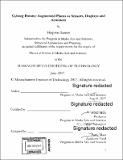| dc.contributor.advisor | Pattie Maes. | en_US |
| dc.contributor.author | Sareen, Harpreet | en_US |
| dc.contributor.other | Program in Media Arts and Sciences (Massachusetts Institute of Technology) | en_US |
| dc.date.accessioned | 2018-03-12T19:28:16Z | |
| dc.date.available | 2018-03-12T19:28:16Z | |
| dc.date.copyright | 2017 | en_US |
| dc.date.issued | 2017 | en_US |
| dc.identifier.uri | http://hdl.handle.net/1721.1/114063 | |
| dc.description | Thesis: S.M., Massachusetts Institute of Technology, School of Architecture and Planning, Program in Media Arts and Sciences, 2017. | en_US |
| dc.description | Cataloged from PDF version of thesis. | en_US |
| dc.description | Includes bibliographical references (pages 94-98). | en_US |
| dc.description.abstract | Plants are photosynthetic eukaryotes with a billion years of evolutionary history. While primarily sessile, they have developed distinctive abilities to adapt to the environment. They are self-powered, self-fabricating, self-regenerating and active signal networks. They carry highly advanced systems to sense and respond to the environment. We strive for such sensing and responses in our electronics; self growing or self repairing abilities in our architecture; and being sustainable at scale in general. The industrial and technological thought process has mostly been devising artificial means or replicating natural systems synthetically. However, I propose a convergent view of technological evolution with our ecology where techno-plant hybrids are created. The approach is to formulate symbiotic associations and to place the technology in conjunction with the plant function(s). In this thesis, I go from the outside to inside the plants in conceiving such synergetic processes and present case studies of their implementation and analysis. I begin with a robot-plant hybrid where the robotic device adds mobility and is triggered with the plant's own signals. Next, lead (II) detection nanosensors are presented which reside inside the leaf of a plant and continuously sample through plant hydraulics. This is followed with a design study for plants with new conductive channels grown inside them and their subsequent use as inconspicuous motion sensors. I conclude with a symbiotic robot that lives on a sunflower plant and automatically trains or directs its growth with onboard lighting. The end result is an augmented-plant society where technology adds non-native functions or redirects the natural processes.. | en_US |
| dc.description.statementofresponsibility | by Harpreet Sareen. | en_US |
| dc.format.extent | 98 pages | en_US |
| dc.language.iso | eng | en_US |
| dc.publisher | Massachusetts Institute of Technology | en_US |
| dc.rights | MIT theses are protected by copyright. They may be viewed, downloaded, or printed from this source but further reproduction or distribution in any format is prohibited without written permission. | en_US |
| dc.rights.uri | http://dspace.mit.edu/handle/1721.1/7582 | en_US |
| dc.subject | Program in Media Arts and Sciences () | en_US |
| dc.title | Cyborg botany : augmented plants as sensors, displays and actuators | en_US |
| dc.title.alternative | Augmented plants as sensors, displays and actuators | en_US |
| dc.type | Thesis | en_US |
| dc.description.degree | S.M. | en_US |
| dc.contributor.department | Program in Media Arts and Sciences (Massachusetts Institute of Technology) | en_US |
| dc.identifier.oclc | 1026501855 | en_US |
